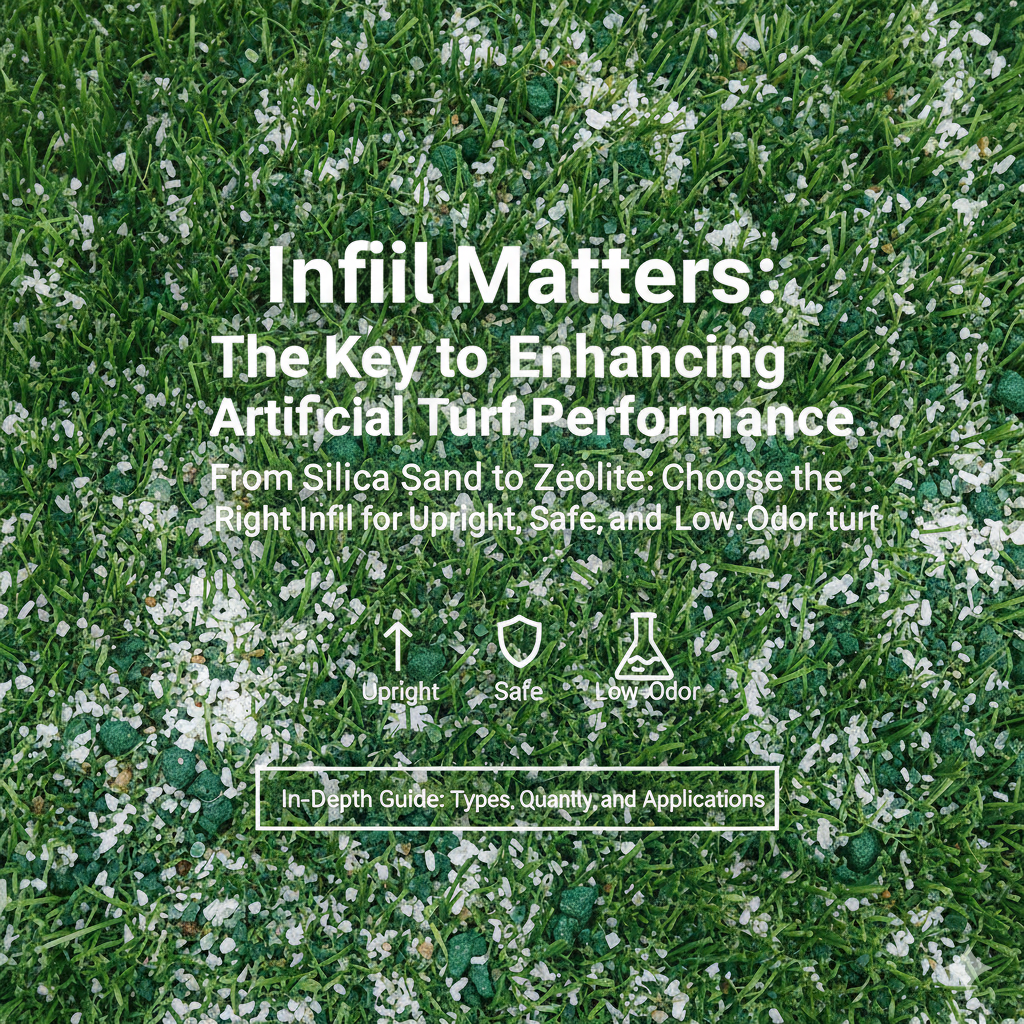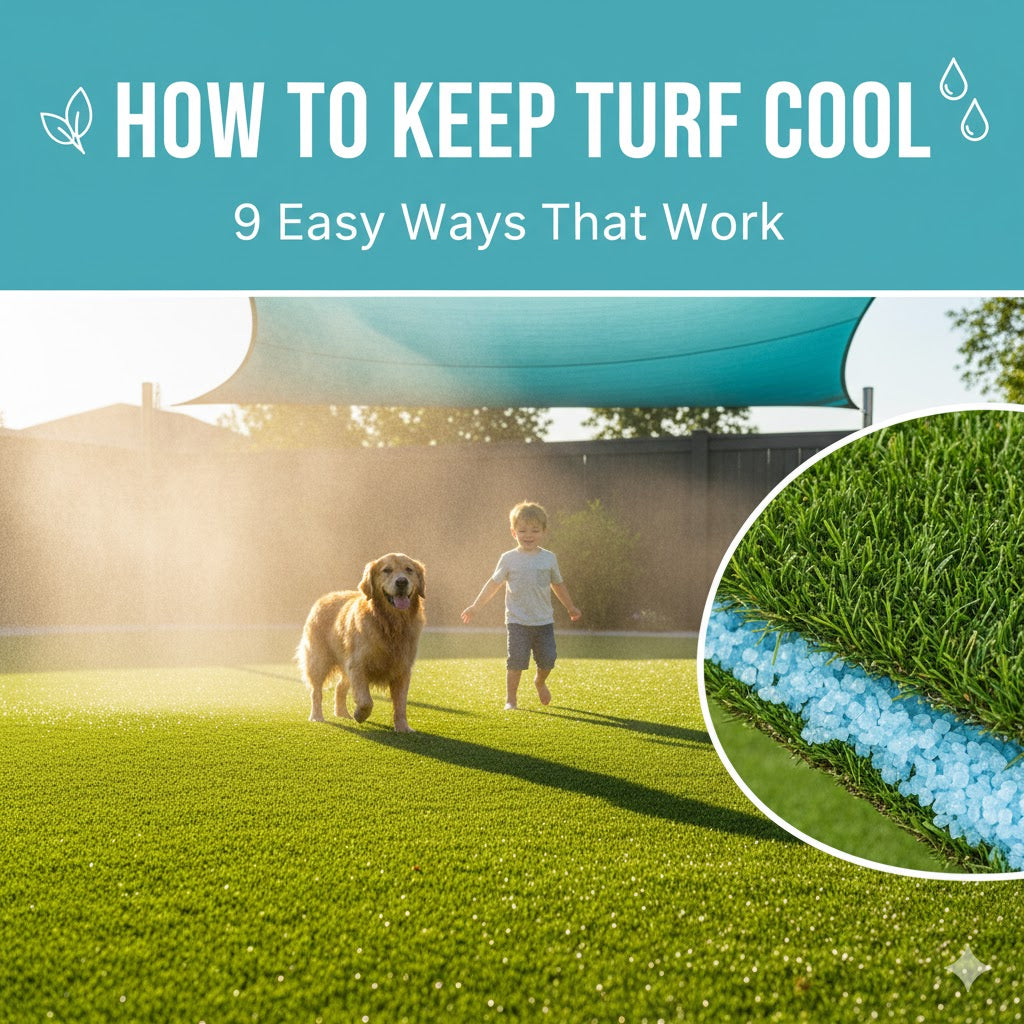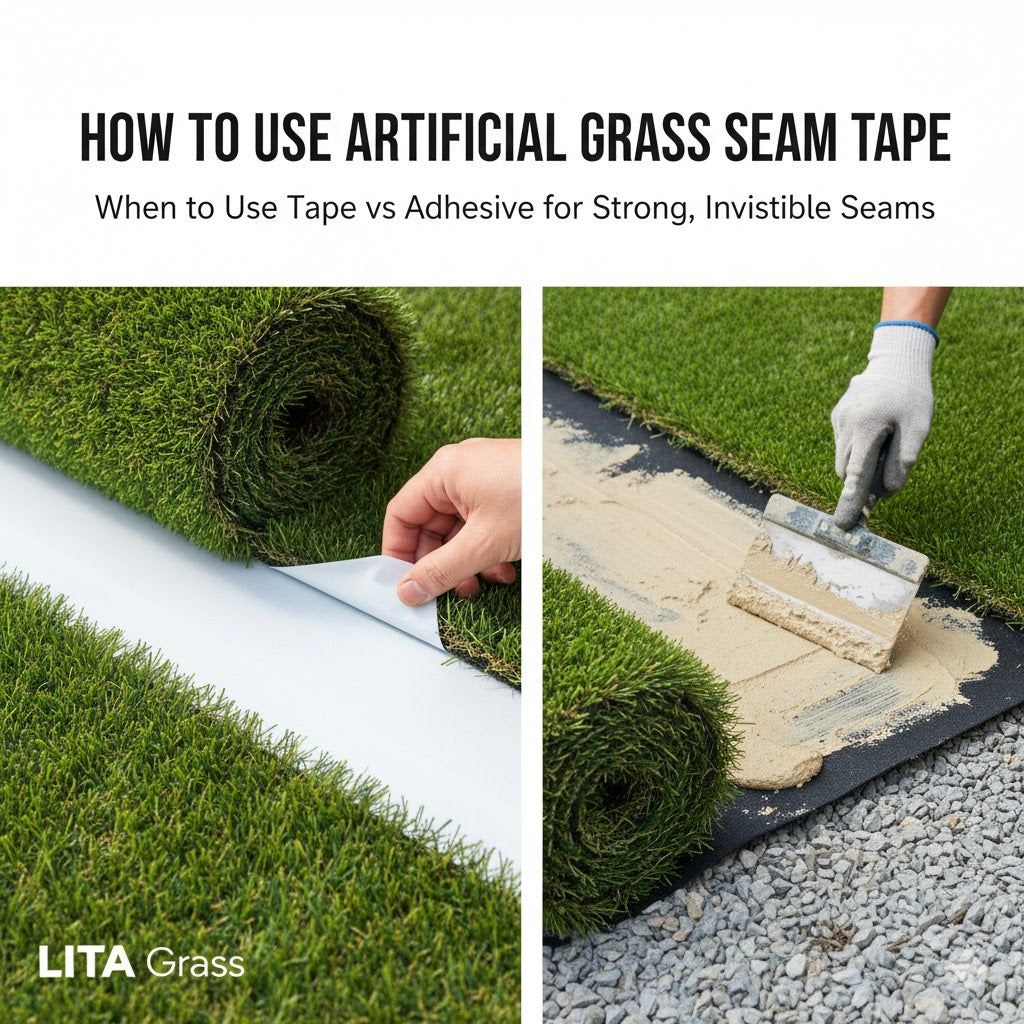Laying artificial grass is only part of the job. What really makes the turf look natural and perform well is the infill that sits between the blades.
Infill does a lot more than you might think. It props up the grass fibers, adds softness underfoot, and keeps the turf from shifting or wrinkling. Some types even help control odors, improve drainage, or keep the surface cooler on hot days.
In this guide, I’ll walk you through the main infill options, explain how much you’ll need, and show you when each type works best. We’ll also cover some simple math to estimate bag counts and share tips for lawns, pet areas, play spaces, and putting greens.
By the end, you’ll know exactly how to choose the right infill for artificial grass and how to avoid the common mistakes that shorten turf life.
What Is Artificial Grass Infill (and Why Does It Matters?)
Artificial grass infill is the material that installers spread between the blades of turf after it’s rolled out. Think of it as the soil under natural grass. Without soil, blades fall flat. Without infill, synthetic blades do the same.
The infill has several important jobs. It keeps turf fibers standing tall, so your lawn looks full instead of matted down. It also weighs the turf down like ballast, which prevents wrinkling, shifting, or lifting in heavy wind or heat.
Another big role is protection. Infill adds a cushion that reduces impact, which helps with comfort, safety, and shock absorption. It also shields the turf’s backing from foot traffic, UV rays, and everyday wear and tear.
Depending on the type you choose, infill can also help with drainage, odor control, and even cooling the surface on hot days.

Types of Infill for Artificial Grass
There isn’t just one kind of turf infill. Each type has its own strengths, limits, and best uses. The right choice depends on how you plan to use your lawn, putting green, or play area. Brands such as LITA Grass not only provide turf, but also help homeowners choose the right infill materials to match pile height and usage.
Silica Sand
Silica sand is the most common and most affordable option. It gives stability and keeps the blades upright. But it doesn’t add much cushion and can trap pet odors. It works best in low-traffic areas or decorative spots where you don’t need much shock absorption.
Coated Silica Sand (Envirofill or Durafill)
This option has a rounded quartz core coated with an acrylic layer. The coating often includes antimicrobial protection, which helps with odor control and bacterial growth. It costs more than plain silica sand, but it lasts longer and stays cleaner. It’s a strong pick for families with kids or pets.
Zeolite (Zeofill)
Zeolite is a natural mineral that absorbs ammonia from pet urine. That makes it a popular top-layer choice in pet zones. It can reduce pet odors, but it’s usually paired with another infill like sand to give enough weight and stability.
Crumb Rubber
Made from recycled tires (Styrene-Butadiene Rubber), crumb rubber is common on synthetic turf fields. It adds bounce and shock absorption, which helps with player safety. The downside is that it holds heat, leaves black dust, and isn’t ideal for residential lawns.
EPDM Rubber and TPE
EPDM rubber and Thermoplastic Elastomers are virgin materials made for turf. They can be colored, perform consistently, and resist breaking down. These are often chosen for sports or play areas where consistent performance and durability matter more than cost.
Organic Infills
Options like cork, coconut shells, or walnut shells are all-natural. They absorb less heat than rubber and can keep the surface cooler. They may need more upkeep, though, because organic infills can shift, float, or break down faster in some climates.
Specialty Cooling Infills
Some coated sands, such as HydroChill, are designed to stay cooler when watered. They can drop surface temperatures, but only when moisture is present. They’re a premium option and often used in hot climates where heat is a big concern.

How Much Infill Do You Need?
The right amount of infill depends on pile height, turf type, and how you plan to use the space. Taller blades need more support, and heavy-use areas need more weight and cushion.
A common rule is to use about 1.5 to 3.5 pounds of infill per square foot for normal landscaping. For high-traffic lawns or play areas, you might need closer to 3 pounds. A standard 50 lb bag usually covers 15 to 25 square feet, depending on depth.
For putting greens, the numbers change. Texturized greens with short blades use about 1.5 to 2.5 pounds of fine infill per square foot. Sand-filled greens with taller blades may require 4 to 6 pounds of round raw sand, plus a smaller top layer of coated sand.
Sports fields use even more because they include both a base ballast layer and a performance infill layer. Total infill amounts can reach 5 pounds or more per square foot. These systems often include a shock pad for consistent shock absorption and impact safety.
Choosing the right infill for artificial grass isn’t only about weight. You also need to follow the turf manufacturer’s guidelines for infill depth and check your specific pile height. This ensures your turf fibers stay upright and your surface stays safe and stable.
When to Use Each Infill
Not every lawn or field needs the same infill. The best choice depends on how the turf will be used and who will be using it.
For a simple backyard or low-traffic artificial lawn, plain silica sand can work well. It’s affordable and provides enough weight to hold turf fibers upright.
Families with kids or pets should consider coated silica sand. It resists compaction, helps with odor control, and is safer for play areas. If odors are a concern, add zeolite as a top layer in pet zones.
In hot climates, organic infills like cork or walnut shells help lower surface temperature. Some homeowners also choose cooling coated sands, but remember they work best when watered.
Sports fields are different. They usually use a system of sand and rubber infill, sometimes with EPDM or TPE for better performance. A shock pad is often added for consistent shock attenuation and impact safety.
So, when picking the right infill for artificial grass, match the type to the job: budget for simple lawns, coated or zeolite blends for pets, organic or cooling options for heat, and layered systems for sports.
Care & Maintenance: Keep Performance High and Odors Low
Infill doesn’t last forever. It shifts, compacts, and sometimes washes away. That’s why regular care is key.
Brush the turf fibers a few times a year. Tools like a stiff broom or a Grandi Groom rake work well. This keeps blades standing tall and spreads the infill evenly.
Check the infill depth at least once a year. In busy areas or play zones, check every six months. If levels are low, add a thin layer at a time. Too much infill at once can cause matting or poor drainage.
For pet areas, rinse the turf often. This helps prevent odor buildup. Some people also use enzyme cleaners, but the right infill choice does most of the odor control work.
In hot weather, shade and smart scheduling help more than anything. You can also use an infrared thermometer to monitor surface temperature if kids or pets play outside.

Common Pitfalls (and How to Avoid Them)
Many turf problems come from mistakes with infill. The good news is that they’re easy to avoid once you know them.
One common mistake is underfilling tall turf. Without enough weight, blades fall flat, wrinkles form, and the turf backing wears out faster. Always follow the pile height and infill depth guidelines.
Another pitfall is using 100% zeolite everywhere. Zeolite is great for pet odors, but it doesn’t add enough weight on its own. Use it as a top layer, not the base.
Some homeowners also expect cooling infills to solve heat problems completely. These products help, but turf will still get hot. Shade, timing, and water make the bigger difference.
Finally, many people skip the turf manufacturer’s instructions. Every artificial turf product has its own requirements for infill materials and amounts. Ignoring those specs can lead to poor performance and even void a warranty.
FAQs About Turf Infill
Can I install turf without infill?
Technically yes, but it’s not a good idea. Without infill, turf fibers flatten, shift, and wear out quickly. Most turf systems are designed to include infill.
What is the best infill for pet owners?
A mix works best. Use silica or coated sand as the base, then add a top layer of zeolite. This gives weight, drainage, and odor control.
How much infill should I buy?
A safe range is 2 to 3 pounds per square foot for most lawns. Check your turf’s pile height and always follow manufacturer guidelines. A 50 lb bag usually covers 15 to 25 square feet.
What’s the coolest infill option?
Organic infills, like cork or walnut shells, absorb less heat. Coated sands with cooling tech also help, but turf will always get warmer than natural grass.
Conclusion: Picking the Best Infill for Artificial Grass
The right infill makes artificial grass look better, feel better, and last longer. It keeps turf fibers upright, adds comfort, and protects the turf system from wear and tear.
Silica sand works for budget lawns. Coated sand or Envirofill is a smart pick for families and play areas. Pet owners should add zeolite for odor control. Sports fields often use layered systems with sand, rubber, or EPDM for shock absorption and player safety.
How much you need depends on pile height, square footage, and traffic. Most lawns take 2 to 3 pounds per square foot. Playgrounds and sports fields often need more. Always follow the turf manufacturer’s specifications for infill materials and amounts.
No matter what type of infill you choose, buying from a supplier that stands behind its turf is important. LITA Grass offers free samples, fast U.S. shipping, and a clear warranty policy, making them a solid option for homeowners looking to get started. Contact us Today.



Leave a comment
This site is protected by hCaptcha and the hCaptcha Privacy Policy and Terms of Service apply.